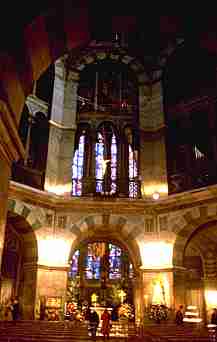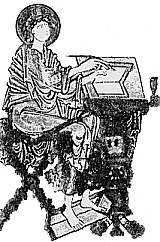






If you are looking at this page without frames, there is more information about medieval writing to be found by going to the home page (framed) or the site map (no frames).
| Monastic Scribes and Libraries (2) | |||
| Benedict and Cassiodorus were literate in their native language and the scribes of their monasteries were writing in the same language that they understood as the spoken word. While Latin was the spoken language of the church, not only of liturgy but of international communication, in the most remote corners of Christendom scribes were writing in a language which they had learned through written rather than oral means. Irish and Anglo-Saxon scribes studied the works of the Latin grammarians and wrote out their works applying the principles of these authors. They introduced consistent word spacing and forms of punctuation, rather than using continuous script, to produce a written code of meaning, not simply a phonetic stream of sound symbols. (See Parkes 1991) | |||
 |
|||
| A small grab from the Vespasian Psalter (British Library, Cotton Vespasian A1, f.31), an 8th century volume produced in Canterbury using uncial script, has been marked here with little red lines to show the word breaks. The spacing as produced by the scribe does not coincide. By permission of the British Library. | |||
 |
|||
| The script of the 7th century Book of Kells (Dublin, Trinity College Library), showing word spacing and insular half uncial script. (From Steffens 1929) | |||
| When looking at the spread of literacy in the 7th and 8th centuries, one is not seeing some sort of wave washing across the landscape. Rather, there is a very finite number of isolated points which nevertheless interacted, as not only were books donated and lent for copying, but monks migrated and set up centres of learning in distant places. The move was not all in the direction of from Rome outwards, as Anglo-Saxon monks set up in Germany and Irish monks in Italy. The monasteries housed an international intellectual elite. | |||
| As they became centres of literate education as well as religion, the variety of books which they produced and copied increased. While the patristic works of the founders of Christianity got them started, these were not works of their own ethnic culture. The new European fathers of the church like Gregory the Great, Isidore of Seville and Bede expanded the literature with works which were truly their own. The increasing need to teach Latin literacy in the monastic schools resulted in the rediscovery and copying of works of the Latin Classics and of Latin grammar. It is claimed that the Emperor Charlemagne took a personal interest not only in the development of his own royal library, but in those of the monasteries in his realm. |
 |
||
| The interior of Charlemagne's Palatine Chapel at Aachen. | |||
| Monastic institutions were developing larger and more diverse teaching libraries. The development of industrious centres of writing resulted in new localised scripts which were written more rapidly than the laboriously copied majuscule or half uncial scripts of the past. Despite the rather inappropriate term National Hands, which is often applied to these scripts, they developed and diversified in specialist centres. Particular scripts were associated, for example, with the abbeys of Luxueil and Corbie, but not exclusively as books were loaned and new scribes learned their craft within their area of influence. Insular minuscule was written in European centres like Bobbio, Fulda or St Gall and influenced developing local styles. | |||
 |
|||
| Sample of a distinctive script of Corbie, Corbie ab from a manuscript of c.800 (Imperial Library of St Petersburg, F. XIV,1). (From Steffens 1929) | |||
| As libraries developed, so did the administrative mechanisms for looking after them. The earliest library catalogues which survive date from the early 9th century, and represent a period of great expansion of the holdings of those institutions. The oldest catalogue from the cathedral library of Würzberg, of around 800, lists 35 items. A catalogue from Reichenau of around 822, the original of which is now lost, listed over 400 volumes. Catalogues of similar date survive for a number of monasteries and show diversified collections for the practice of liturgy, for the study of the Christian religion and for the study of literacy and Classical scholarship. | |||
 |
The accumulation of libraries of hundreds of volumes would have been an arduous process, but it would not have been beyond the capabilities of a restricted number of specialist scribes working steadily over the years. While works were undoubtedly recopied and replaced, surviving works show that some books were preserved in these libraries for centuries. One might assume that for a scribe of special talent, the time required in choir to recite the divine office might be excused or modified given that the work itself was a tribute to God. As the works transcribed became more numerous and diverse, one assumes that the scribe became less of a simple copyist and more of a literate scholar. | ||
| Monastic scribes did not just transcribe books and they did not just produce material for their own use. In the days before literate bureaucratic processes were fully in place, the monasteries were recruited to write legal documents such as charters, and not only the ones that were produced for their own benefit. Charlemagne had a royal chancery, but in England there is not believed to have been one until Edward the Confessor, and even at that date it is not certain that it was an entity entirely separate from religious institutions. As literacy became more significant to the world at large, the monastic scribes became more engaged with it. | |||
 |
|||
| The first two lines of a charter of King Coenwulf of Mercia from 812 AD. The script is an insular minuscule book hand, as used by the monastic scribes for copying books. (From Wright 1879) | |||
| As new monastic orders developed, like the Cluniacs and Cistercians, chains of transcription were set up to establish the libraries for these expanding groups. Certain distinctive styles developed within the orders as books were lent and copied within them, reflecting certain aspects of their values. The austerity of style preached by St Bernard, for example, was reflected in the illustrations in Cistercian manuscripts, which were entirely executed in monochrome for a time. Extravagant use of colour was considered decadent and Cluniac. |
 |
||
| A medieval statue of St Bernard in the church at Fontaine-les-Dijon. | |||
| The most stunning coherent collection of manuscripts I have seen was a collection of Cistercian manuscripts exhibited in Dijon in 1998. A two CD-ROM set, The Treasure of the Lowly, shows the magnificent manuscripts and their historical setting. It has taken me six years to discover where to buy it! | |||
| Cistercian scribes developed their own range of punctuation marks, used to prompt the reader who read aloud in the refectory. These were also adopted by the Dominicans. | |||
| Preaching orders like the Dominicans and Franciscans required a great deal of compiled and exemplar material for their work of oral teaching. Works like the encyclopedic compilation of Isidore of Seville, or later compiled works drawn from authors in their own ranks like Vincent of Beauvais or Bartolomeus Anglicus were specialities of their library collections. | |||
|
|
|||
|
|
|||
|
|
|||
|
If you are looking at this page without frames, there is more information about medieval writing to be found by going to the home page (framed) or the site map (no frames). |
|||